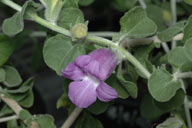In Flower This Week
A weekly news sheet prepared by a Gardens' volunteer.
Numbers before each plant refer to temporary IFTW labels in the gardens.
Numbers in square brackets [ ] refer to garden bed Sections. Plants in flower are in bold type.
View past issues of 'In Flower This Week'.
15 February 2013
Eremophila strongylophylla click for larger image |
This walk passes numerous flowering plants of which only a few will be mentioned. It is interesting to view the many banksias now producing immature flower spikes.
- Pots beside the doors of the Visitor Centre are bright with Rhododendron viriosum with orange-red bell-shaped flowers and the large red dark-centred pea-shaped flowers of the Sturt’s Desert Pea, Swainsona formosa. Another pot edging Banks Walk contains a small blue-flowering plant, Platytheca galioides [Section 174].
- Ground-covering Scaevola albida [Section 174] is a dense plant with pink fan-shaped flowers.
- Another ground cover, Pelargonium rodneyanum [Section 174], is also dense and bright with cerise flowers.
- Take the Main Path past the cafe to view Correa ‘Canberra Bells’ [Section 240], the flower selected to commemorate Canberra’s centenary in 2013. They are most attractive with their red and yellow bell-shaped flowers.
- The backdrop is Correa ‘Summer Belle’ [Section 240] with differing leaf shapes and slimmer bell-shaped flowers.
- At the end of this section Callistemon viminalis [Section 310] is a large spreading shrub with willowy habit crowned with deep red bottlebrush flowers.
- Take the road to the left beside the building, passing Melaleuca lanceolata [Section 10], a woody many-branched shrub crowned in profusion with small ivory-shaded bottlebrush-like flowers.
- Take the path to the right where a newly developed area displays emu bushes including Eremophila strongylophylla, [Section 302], a low spreading plant with violet trumpet-shaped flowers.
- At the next corner Callistemon chisholmii [Section 10] has soft pink bottlebrush flowers dangling from its willowy branches.
- Down the side-road the large shrub clad with red bottlebrushes is Callistemon citrinus [Section 9]. Opposite it is Callistemon brachyandrus [Section 11] which is covered with orange-coloured bottlebrushes.
- Follow the Main Path to the right. A group of waratahs includes Telopea mongaensis [Section 30], a smaller shrub displaying its deep pink flowers.
- Babingtonia ‘Howie’s Feathertips’ [Section 30] is sprinkled with tiny white flowers over the fresh green shrub.
- Banksia ‘Birthday Candles’ [Section 30] is a dwarf spreading shrub bearing many pencil thin green immature flower spikes.
- At the next crossroad, Grevillea ‘Coconut Ice’ [Section 25] has large terminal red-cream flower spikes on a low spreading shrub.
- Across the road Grevillea ‘Lady O’ [Section 26] has long lateral branches on the low shrub which bears bright red flowers.
- Grevillea juniperina ‘Pink Lady’ [Section 24] is a low spreading shrub bearing many soft pink terminal flowers.
- Following the Main Path, a Geebung, Persoonia acerosa [Section 26], is a low dense shrub with short fine leaves covering the branches which terminate with tiny narrow tubular yellow flowers.
- Beside it is Grevillea ‘Canterbury Gold’ [Section 26] with golden yellow spider-like flowers on the low lateral branches.
- Across the next road, filling a corner is a picturesque setting of Correa ‘Canberra Bells’ [Section 112] bearing colourful red and yellow bell-shaped flowers.
Return by any path in a reverse direction where other flowers can be admired.
Barbara Daly
![Director of National Parks [logo]](../../../../images/dnp_90px.gif)







